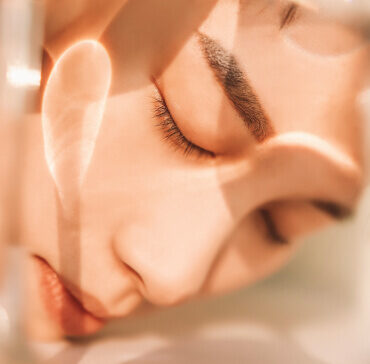

Diabetes Caused My Hair To Fall Out—Here’s What Helped Me Grow It Back
Of the many aspects of my appearance that have caused me insecurity over the years, my hair was never among them. Like any woman of a certain age, I’ve had my slew of bad haircuts, and there’s certainly been no shortage of breakage and split ends. In general, though, my hair has always been healthy, strong, and thick.
And then, toward the end of 2023, I noticed I was suddenly losing more hair than usual—in the shower, on my hairbrush, and even around the house and on my clothes. I chalked it up to seasonal shedding heading into winter and thought that perhaps my hair was also adjusting to less frequent washing since I’d recently abandoned my every-other-day shampoos in favor of a once-weekly regimen.
But as the days turned into weeks and the weeks turned into months, the hair loss only continued, and after a while, it started to show not just on the surfaces around me but on on my head. My hair was visibly thinner, both when I wore it down and when I put it up in a ponytail. It also felt much less dense when I ran my fingers through it or pulled it back.
Getting Answers
I was in the dark as to what was causing this sudden and significant hair loss, but my stylist had a hunch. See, I was unexpectedly diagnosed with type 1 diabetes in September of 2023, and she asked about the timeline of events and wondered if it could be a reaction to being hyperglycemic (having unhealthily high blood sugar) for the many months before I was officially diagnosed. I decided to do a little digging (reporter, here!) and soon learned just how intimately the two can be intertwined.
It turns out that excess blood sugar can not only damage nerves and organs like the eyes and kidney, it can also wreak havoc on the blood vessels responsible for delivering oxygen to hair follicles to stimulate hair growth and maintain its health. “Like other organs in the body, hair follicles require sufficient blood flow for the delivery of oxygen and vital nutrients,” explains Priya Jaisinghani, MD, a board-certified endocrinologist in New York City. And because hair growth happens in phases, the loss often doesn’t start to show until months after the fact, which is likely what happened to me.
It struck me that, even as a longtime beauty editor, I had never heard of any connection between blood sugar and hair density. I was also surprised there hadn’t been more discussion about it given how many people struggle with high blood sugar. An estimated 56 million individuals in the U.S. are affected by hair loss, and although myriad studies have established the connection between hyperglycemia and hair shedding, even noting hair loss as an early sign of diabetes, many people remain unaware of the correlation.
Hyperglycemia is a phenomenon that occurs most often among diabetics, especially those who have not yet been diagnosed, but it’s not just the roughly 40 million Americans living with the disease who are vulnerable to it. In fact, high blood sugar is a symptom of many other conditions, as well as hormonal disorders, and can even be a side effect of certain medications. “According to the CDC, 97.6 million people, or almost 40% of the adult US population, have prediabetes, a condition where blood glucose levels are higher than normal, but not yet high enough to meet the criteria for diabetes,” says Dr. Jaisinghani. In this group, hyperglycemia is a near-constant, as are the effects it can have on the body. “Additionally, environmental factors, such as a diets high in sugar and physical inactivity, as well as stress and even physical illness contribute to hyperglycemia,” Dr. Jaisinghani adds. “And certain medications, particularly steroids, can also lead to elevated blood glucose levels.”
The root of it
High blood sugar can impact large and small blood vessels both directly and indirectly, leading to what are called micro- and macro-vascular complications. One of these complications is reduced blood flow through the vessels to hair follicles. “The dermal papilla, which sits at the base of the hair follicle, helps to regulate the hair growth cycle and supplies the hair follicle with nutrients to support hair growth,” says Marisa Garshick, MD, a board-certified dermatologist in New York City. “The blood vessels feed that dermal papilla.” So, if these vessels are damaged, the nutrients needed can’t be delivered and hair growth will be affected.
And while hyperglycemia-induced hair loss can technically happen in any population, a 2019 study did find that type 2 diabetes can lead to an increased risk of severe central hair loss in African American women, in particular. And even if the high blood sugar isn’t directly responsible for the shedding, it could be contributing to other factors related to thinning. “The physical or psychological stress of living with hyperglycemia can lead to a condition called telogen effluvium, which is classified as sudden, dramatic shedding that comes out of nowhere,” explains Dr. Jaisinghani. “Not to mention thyroid disorders are more prevalent in those living with diabetes, and those too can contribute to hair loss.” Some studies have also found an association between insulin resistance, metabolic syndrome, and hair loss.
Doing the time
Since hair growth happens in four phases—anagen, or growth; catagen, or regression; telogen, or rest; and exogen, or shedding—it can take some time to see the impacts of hyperglycemia. “Health changes can take at least two to three months to have an effect on the hair,” Dr. Garshick explains. “For people experiencing a temporary change in their health or a medical condition, including high blood sugar related to diabetes, this can trigger an episode of telogen effluvium, which results in a temporary period of increased hair shedding.” If the health condition is corrected—as would be the case when high blood sugar is lowered—the hair loss will stop.
But as I learned firsthand, the actual effects of the hair loss may only show after the cause is treated or nullified since the shedding phase of the hair cycle happens several months after the growth may have been hindered. So, if you are experiencing hair loss now, the best way to determine the reason is to examine your health, environment, and lifestyle three to four months ago.
Taking action
The most important thing to do after experiencing hair loss because of high blood sugar is to lower your blood sugar to healthy levels, with the help and guidance of your healthcare provider. “You should also talk to them about ensuring adequate protein and iron intake to promote optimal hair health,” Dr. Jaisinghani advises. “And since both physical and psychological stressors can impact hair health, it is important to practice stress reduction techniques.” If hair loss persists, ask your doctor about the possibility of seeing a specialist to explore medication and other options.
Of course, there are also several at-home hair products, supplements, and devices, as well as in-office treatments, that can promote hair growth and health once blood sugar is stabilized. “While it is always best to optimize the underlying trigger, there are some options to strengthen and support hair growth,” Dr. Garshick says. “These may include hair vitamins and supplements such as Nutrafol and Viviscal, and strengthening and thickening shampoos, conditioners, and leave-in products.” At-home light devices are also great, clinically-proven options for strengthening hair and reducing shedding. In-office treatments, like low-level laser therapy and PRP, have also been shown to help promote growth and increase density.


